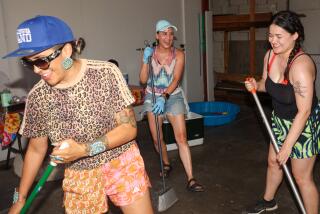Treasures Behind a Facade : A museum of Native American culture near Lancaster is a relic of America’s ethnocentric past but also has many intriguing artifacts.
LANCASTER — Surrounded by the San Gabriel Mountains, towering Joshua trees and miles of bleak desert lies a Native American museum housed in a--Swiss chalet?
The Antelope Valley Indian Museum, a paean to America’s ethnocentric past, fortunately harbors treasures behind its facade of scalloped facia boards painted with pastel butterflies and bluebirds. Artifacts dating back 1,200 years reveal what life was like for the Southwestern, California and Great Basin Native Americans. For kids, there are opportunities to grind corn on stone metates and to see how spear points were made. An adjacent half-mile nature trail provides a way to learn about the surrounding environment.
Spring is an ideal season to visit the museum, 18 miles southeast of Lancaster in the southwest corner of the Mojave Desert. Warmer months bring carpets of purple lupine, white evening primrose, dune primrose, flowering creosote bushes and, of course, the bushy, creamy-white blooms of the Joshua tree.
Amateur archeologist Howard Arden Edwards homesteaded the site in the 1920s, using a four-cylinder 1927 Chevy to haul supplies. Building began in 1928 around huge granite boulders that jut into the structure’s living room and form the floor of an upper room. Edwards, a Jack-of-all-trades who was a theatrical scene painter and circus clown, used the upper room to house his vast collection of prehistoric and historic Native American artifacts.
Anthropology student Grace Wilcox Oliver happened upon the site while hiking in 1938. She bought it from Edwards, and in 1940 opened it as a museum. The state of California purchased the property in 1979 and, after renovations, reopened the museum in 1982.
1 p.m.: The sight of the museum in the distance--its seven pastel peaks looking downright storybook among the rugged terrain--may take you aback. Now might be a good time to explain to fellow travelers the reason for the curious juxtaposition.
“I’ve come to realize that the museum represents 60 years of how we have interpreted American Indian culture,” said curator Edra Moore. “In the ‘30s, artifacts were called ‘novelties’ and ‘curios.’ Then we looked at other cultures in terms of what it took for them to live, adapt and survive in their environment. Now it’s more about scientific methods--why does one group flourish and another perish? That’s all found in the museum.”
Enter the museum’s main room, Edwards’ former living room, now called Kachina Hall for the rows of Hopi kachina dolls placed on beams below the soaring, pitched ceiling that’s painted with large kachina dolls.
Native American motifs are painted on the rafters and beams, faced with the spongy wood from Joshua trees. A bear hide hangs from a beam opposite a stuffed caribou and a deer head. Black Southwestern pottery made by Santa Clara Pueblo tribes and baskets built by Hopis, Papagos and Piutes line tables, just above large stone metates .
“Kids love this room,” Moore said. A walk along stone steps through a cavelike opening leads to the upper room, built on top of a rock formation. Edwards’ collections from the Santa Barbara coast and the Channel Islands are here--bone tools, worn metates and arrowheads. The artifacts are displayed as Edwards presented them; many are glued on cardboard sheets with hand-printed explanations.
A series of cards show everyday articles used by cultures under the titles “The Dawn Maid,” “Teko, the Maker of Beads” and “The Mighty Warrior Who Loved the Dawn Maid.” And for the height of ethnocentricity, an exquisite carved ceremonial pipe is titled “A Woman’s Cigarette Holder.”
1:45 p.m.: Just beyond the living room is the Southwest Room, the former dining room. Oliver outfitted the room with lighted display cases that show dioramas Edwards built, along with thousand-year-old artifacts made from the yucca plant--sandals, robes and skirts. Prehistoric pottery shards also are displayed, some from the cliff-dwelling Anasazi, along with carved stone effigy pots in which the Hohokam, who lived near what is now Phoenix, ground paint.
The Great Basin Room, a former kitchen, has been renovated into the museum’s most modern wing. Photographic cutouts of the 1860s reveal how various tribes, mostly from Utah, eastern California and New Mexico, lived and adapted to their environment.
The Antelope Valley Room, just off the former kitchen, features display cases showing projectile points, mortars and pestles and items traded by the area’s cultures: shell ornaments, obsidian spear points and other weapons. Just beyond the room is the museum’s gift shop, stocked with Southwestern Native American hand-crafted jewelry, kachina dolls, pottery, rugs, fetishes and publications on Native American history.
2:30 p.m.: Visit Joshua Cottage, an adjacent building that houses Mexican colonial paintings in a small room where occasional educational programs are held. A touch table in the next room is strewn with baskets of corn, Joshua seeds and pods, manzanita berries, acorns, pinyon nuts and chia seeds--typical food used by Native Americans. Kids can grind corn on metates and watch as a docent demonstrates a fire-starting tool built from sticks.
3:15 p.m.: The half-mile nature trail leads from Kachina Hall into the desert framed by craggy rock formations that jut into a vast sky. Don’t forget to look up--you may spot soaring golden eagles or red-tailed hawks.
There are 14 signposts along the trail that can be used in tandem with a nature trail guide booklet. The trail winds around Joshua trees, rock formations and an old barn Edwards built. It is a good point from which to view native plants and perhaps a few critters--the kangaroo rat, cactus wren, jack rabbit and road runner.
Where and When
What: Antelope Valley Indian Museum.
Location: 15700 E. Avenue M, Lancaster.
Getting there: Take California 14 north to Lancaster, exit on Avenue K, turn right, head east for 17 miles. Turn right on 150th Street, marked by a brown museum sign. Go two miles to Avenue M and turn left at a crossing also marked by a museum sign. Look for the museum gate on your left within a quarter of a mile.
Hours: 11 a.m. to 4 p.m. Saturdays and Sundays from October through mid-June. Arranged tours are given on Tuesdays and Thursdays.
Price: $2 general and $1 for children ages 6-12.
Call: (805) 946-3055.
More to Read
Sign up for The Wild
We’ll help you find the best places to hike, bike and run, as well as the perfect silent spots for meditation and yoga.
You may occasionally receive promotional content from the Los Angeles Times.






